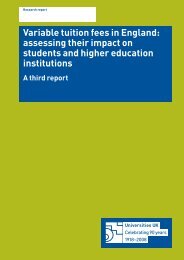The future size and shape of HE - Universities UK
The future size and shape of HE - Universities UK
The future size and shape of HE - Universities UK
- No tags were found...
You also want an ePaper? Increase the reach of your titles
YUMPU automatically turns print PDFs into web optimized ePapers that Google loves.
Factoring in current trends <strong>and</strong> policies20 We have identified <strong>and</strong> analysed four main areas<strong>of</strong> policy relevant to <strong>future</strong> student dem<strong>and</strong>:p <strong>The</strong> government’s policies for 14- to 19-yearoldswhich aim to increase the proportion <strong>of</strong>young people gaining level 3 qualifications <strong>and</strong>progressing to higher education through theintroduction <strong>of</strong> diplomas <strong>and</strong> the requirementon young people to remain in education ortraining until the age <strong>of</strong> 18. <strong>The</strong> impact <strong>of</strong>these policies is uncertain but it should benoted that participation rates have scarcelyincreased since 2000. If these measures were,together, to achieve a three percentage pointincrease in participation in undergraduateeducation, the overall increase in entry wouldbe about 25,000 or 70,000 across all years,predominantly in full-time undergraduatenumbers.p <strong>The</strong> government’s decision to withdrawfunding for students studying for aqualification at an equivalent or lower level(ELQ) than one they already have willparticularly affect enrolments on part-timeundergraduate programmes by as much as40,000 students in total.p <strong>The</strong> trend for more young entrants to highereducation selecting to study part-time. This ismodest <strong>and</strong> from a low base. On currenttrends we would not expect a change <strong>of</strong> morethan about 3,000 students choosing part-timerather than full-time study over the nexttwenty years, particularly in the absence <strong>of</strong>changes in the pattern <strong>of</strong> student support.p <strong>The</strong> impact <strong>of</strong> the increasing level <strong>of</strong> studentloan debt on dem<strong>and</strong> for postgraduate study.This could act as a disincentive to study atpostgraduate level immediately followinggraduation, but this effect is also likely to besmall, representing a reduction in dem<strong>and</strong> forpostgraduate study from home students <strong>of</strong>around 5,000 a year.21 Outside <strong>of</strong> demographic factors we have notbeen able to identify any other current policies ordrivers <strong>of</strong> dem<strong>and</strong> that are likely to lead tosignificant changes on their own.Scenario planning22 It is important to emphasise that scenarios aredevices for exploring a range <strong>of</strong> possible <strong>future</strong>sin the context <strong>of</strong> significant uncertainties in keyareas. <strong>The</strong>y are not forecasts <strong>of</strong> what willhappen.23 We used a two-stage process in developing thescenarios based on key uncertainties <strong>and</strong> drivers– a series <strong>of</strong> three seminars on key drivers <strong>of</strong>dem<strong>and</strong> (funding for students <strong>and</strong> institutions;increased competition in student markets; <strong>and</strong>increased employer engagement) <strong>and</strong> afacilitated scenario planning event based aroundaxes <strong>of</strong> uncertainty – essentially providing ameasure <strong>of</strong> the ranges <strong>of</strong> the key uncertainties.24 However, we also considered briefly, as iscustomary in scenario planning, the majorinternational <strong>and</strong> national developments thatcould have an enormous impact on the <strong>UK</strong>higher education sector. <strong>The</strong>se included climatechange, increased international terrorism, thebreak-up <strong>of</strong> the United Kingdom <strong>and</strong> theaccession <strong>of</strong> Turkey to the EU. All could have amajor impact on dem<strong>and</strong> for higher education inthe <strong>UK</strong>, particularly on engagement withinternational student markets, but we judgedthat in the first instance these were issues <strong>and</strong>risks for governments to manage rather than forinstitutions directly.25 <strong>The</strong> main conclusions from the seminar onfinance <strong>and</strong> funding issues were that over thetwenty year period:p in the face <strong>of</strong> increased competition for publicfunding (within generally less benigneconomic conditions than had been the case inrecent years) <strong>and</strong> in the absence <strong>of</strong> significantadditional funding from employers, anincreased contribution to the costs <strong>of</strong> highereducation would be expected from individuals– graduates <strong>and</strong> students from well-<strong>of</strong>ffamilies – <strong>and</strong> these conditions were likely toapply across the whole <strong>of</strong> the <strong>UK</strong>. This shiftwas likely even with the possibility <strong>of</strong>successive changes <strong>of</strong> government;p higher education institutions faced asignificant challenge to manage performance<strong>and</strong> secure long-term sustainability in the face<strong>of</strong> increased staffing costs <strong>and</strong> pressures onincome;8
















